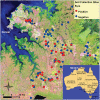Landscape changes influence the occurrence of the melioidosis bacterium Burkholderia pseudomallei in soil in northern Australia
- PMID: 19156200
- PMCID: PMC2617783
- DOI: 10.1371/journal.pntd.0000364
Landscape changes influence the occurrence of the melioidosis bacterium Burkholderia pseudomallei in soil in northern Australia
Abstract
Background: The soil-dwelling saprophyte bacterium Burkholderia pseudomallei is the cause of melioidosis, a severe disease of humans and animals in southeast Asia and northern Australia. Despite the detection of B. pseudomallei in various soil and water samples from endemic areas, the environmental habitat of B. pseudomallei remains unclear.
Methodology/principal findings: We performed a large survey in the Darwin area in tropical Australia and screened 809 soil samples for the presence of these bacteria. B. pseudomallei were detected by using a recently developed and validated protocol involving soil DNA extraction and real-time PCR targeting the B. pseudomallei-specific Type III Secretion System TTS1 gene cluster. Statistical analyses such as multivariable cluster logistic regression and principal component analysis were performed to assess the association of B. pseudomallei with environmental factors. The combination of factors describing the habitat of B. pseudomallei differed between undisturbed sites and environmentally manipulated areas. At undisturbed sites, the occurrence of B. pseudomallei was found to be significantly associated with areas rich in grasses, whereas at environmentally disturbed sites, B. pseudomallei was associated with the presence of livestock animals, lower soil pH and different combinations of soil texture and colour.
Conclusions/significance: This study contributes to the elucidation of environmental factors influencing the occurrence of B. pseudomallei and raises concerns that B. pseudomallei may spread due to changes in land use.
Conflict of interest statement
The authors have declared that no competing interests exist.
Figures


References
-
- Low Choy J, Mayo M, Janmaat A, Currie BJ. Animal melioidosis in Australia. Acta Trop. 2000;74:153–158. - PubMed
-
- White NJ. Melioidosis. The Lancet. 2003;361:1715–1722. - PubMed
-
- Leelarasamee A. Recent development in melioidosis. Curr Opin Infect Dis. 2004;17:131–136. - PubMed
-
- Currie BJ, Jacups SP, Cheng AC, Fisher DA, Anstey NM, et al. Melioidosis epidemiology and risk factors from a prospective whole-population study in northern Australia. Trop Med Int Health. 2004;9:1167–1174. - PubMed
Publication types
MeSH terms
LinkOut - more resources
Full Text Sources

